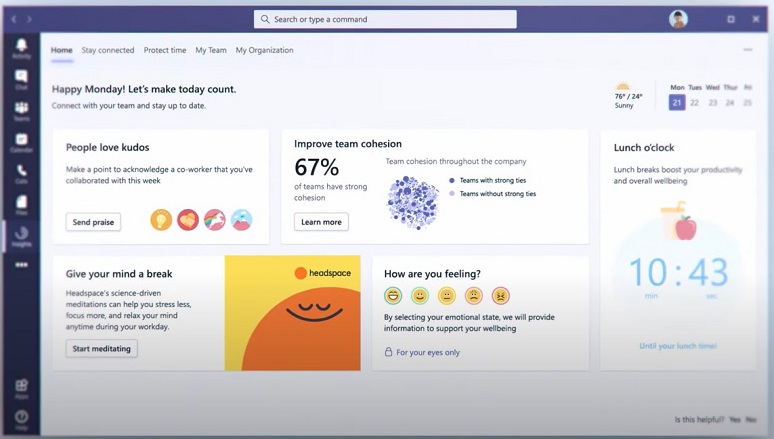Wake up, hop in the shower, get dressed, grab a cup of coffee, sit down at your desk, begin work… and do not leave your desk, more or less, for the next eight to 10 to 12 hours. Does this sound familiar to anyone?
Many people foisted into a work-from-home (WFH) situation due to COVID-19 have taken on some bad habits. Longer hours don’t necessarily translate into increased productivity or thoughtful, focused work, especially as stress increases, burnout ensues, and the ability to think creatively and collaborate fully disappears into a state of mental numbness. Working from home can take its toll on an individual’s health and well-being, and this can result in a negative impact for a company overall.
I was happy to hear Satya Nadella, CEO of Microsoft, address this topic yesterday during his keynote address kicking off the company’s Ignite conference for customers and partners — because, certainly, many of the hours knowledge workers spend toiling away at their desks are done so within one or another Microsoft application. “We know that prioritizing employee well-being is core to an organization's success. It's important to understand what has been lost and what has been gained through this crisis, and especially the balance between optimal organizational productivity and employee well-being,” Nadella told his virtual audience.
“Productivity,” he added, “just can’t be about short-term employee output.”
Rather, organizations must equip employees with tools they can use to “rebuild social capital,” focus, and stay healthy, Nadella said. (For more on the
idea of social capital, see insight from WorkSpace Connect blogger Jon Ingham, an HR specialist.) Additionally, they must measure and improve employee engagement. Microsoft can help out with that, of course, with its workplace analytics and people success management platform, Glint.
“The current situation is quite stark,” said Nadella, sharing o statistics from Microsoft research showing that one-third of remote workers feel their well-being has taken a hit with the lack of work-life separation, for example. What’s more, 30% of knowledge and first-line workers is increasing their feeling of burnout at work, he added.
Microsoft’s answer for all of this lies in weaving well-being features and productivity insights into its widely used Teams collaboration platform. To help people change their bad work habits, Teams users will receive tailored insights and recommended actions, he said. One of the new features, due for availability next year, will allow people to schedule virtual commutes in the morning and evening, providing structure for the remote workday and helping them “carve out the time for cognitive breathers.” The result, Nadella said, will be to allow workers more productive starts in the morning and mindful disconnect in the evening.
In addition, Microsoft will offer integrations with apps like
Headspace, aimed at enabling organizations to support employee health and happiness. While Teams will prompt workers to schedule breaks before calendars get too jammed up, Headspace will provide a means by which they can re-energize and re-focus during these breaks. Nadella put it this way: People should be able to “easily tap into the dedicated moments of mindfulness to make the most of their breaks — something which most people say would help them reduce work-related stress.”
It seems Microsoft, as a chief provider of productivity apps and collaboration capabilities, is moving in the right direction to help keep employees healthy. But will workers feel they have the time to take advantage of such new features? Business managers and HR will have to take accountability here, making sure to build a culture around the principles of health and well-being.



